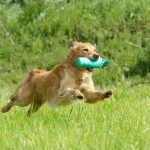By Ryan Eder
I often hear the no-no drill described as a lining drill, but in reality the focus of this drill is to prevent our dogs from flaring off of the line they are being sent.
Running straighter lines through “factors” – obstructions — is the end result, but this is ultimately a de-flaring drill. The no-no drill is a great exercise to do with your dog that requires minimal equipment and can be done while training alone. How is this drill going to help you as a duck hunter? Let’s take a look.
How does this drill apply to the field?
Every year, one of my hunting buddies will say, “Look, I’m a duck hunter; I don’t care about straight lines and technical stuff, it doesn’t matter in the hunt.” As much as I understand that in certain hunting scenarios one may not care about technical retriever performance as much as simply retrieving the shot bird, a dog that truly understands to go straight and not flare heavy cover or other obstructions will be a much more effective retriever.
For example, a few ducks are shot in the marsh, and the bird on the left is behind a cover strip. You send your dog and he flares the strip to the right and picks up one of the other downed birds. Sure, he’s made a retrieve and that’s a good thing, but he may think that he’s successfully picked up the bird on the left. Good luck getting him back to the bird on the left – he’ll glare at you with I already got that one! A dog that does not persevere through obstacles can have his memory affected in multiple retrieve situations.
With that in mind, let’s go through the drill.
No-No Drill Prerequisites
- Sound basic obedience and recall (here command): If your dog flares, the object is to say, “No, here,” and recall him. You would then move closer and re-send.
- Force-fetch (at minimum a reliable retriever): The dog is asked to retrieve repeatedly in this drill.
- Force to pile (at minimum introduced to pile work and strong understanding of concept): The dog is sent repeatedly to a pile of bumpers in this drill.
- Basic handling skills of whistle-sit and three-handed casting: While handling is not required in this drill, I have had cases with young dogs where I have had to sit them on the whistle to gain control. If your dog is not a handling dog, you can still do this drill in close proximity.
Purpose of the No-No Drill
The purpose of the no-no drill is to teach a dog that he must go through cover, over an obstruction (such as a log), or through a slot if it is the line he is sent on. This is applicable to a blind or a marked retrieve.
I like to start this drill in the yard or a training spot with relatively featureless ground. A park or soccer field will work just fine. Bring a few training bumpers and whatever object you’d like to use as your obstacle. I used two wooden fence posts that were easy to transport and carry into the field. Each was approximately five feet in length so when placed end to end, the obstacle was 10 feet long. Start close to the obstacle, maybe 10 yards away, and identify your bumper pile by throwing each bumper over the obstacle to the other side.
After you have established the pile, go ahead and send your dog to make a retrieve. We are starting close to encourage the dog to take a straight line over the top of the fence posts (you can use logs, agility jumps, whatever works best for you). If your dog flares the obstacle and tries going around it, simply say, “No, here,” and get your dog back to the heel position. Walk even closer to the obstacle and try re-sending him. Do this simplification until the dog takes the correct line. Note: No collar pressure is used in this drill; we simply recall our dog, simplify, and teach.
If the dog takes a great line over the obstacle and makes a retrieve, you have a good start! Make sure to encourage the dog to return to you on the same line; it’s important that our dogs take straight lines to and from the retrieve. If your dog flares the obstacle on the return, you have a couple of choices. For the dog that can handle, you can whistle-sit, cast him back to the pile, and recall him again. Keep him on track to come back over the obstacle. If your dog does not handle, simply say, “No,” when he flares, and bring him back to the pile. Make him sit and work back to the obstacle. Then recall him and encourage a straight line back. This approach may look sloppy at first, but if you keep things at close distance to first teach your dog what is being asked, he’ll catch on. Don’t rush; take your time and teach.
Once your dog is demonstrating a clear understanding by consistently doing the drill correctly, you can move back to longer distances and repeat. Remember, distance usually erodes control, so be ready to make corrections. You can do this anywhere from 10 yards to start, up to 100-plus yards if you wish. Sometimes I’ll even set up a few different no-no dills in the same field.
Obstructions
As previously mentioned, I use fence posts that are light to carry from field to field. If you have a field with a downed log or strip of cover, those will also work perfectly. In addition to a log or “hurdle” type obstruction, you can also create a “slot” of some kind. For example, put out two camping chairs or parking cones, and run your dog between them to the bumper pile. The concept is still the same — the dog needs to go where he’s sent, whether it’s through a slot or over an obstruction.
This article first appeared in the December 2017/January 2018 issue of The Retriever Journal.




